Looking for sample homeschool schedules? Keep reading!
Scheduling your homeschool day may seem overwhelming at first, so seeing examples of other families’ schedules can help! In the video and blog post below, we share four common types of schedules, each from real families using The Good and the Beautiful curriculum in their homeschools.
Download sample homeschool schedules in our free printable!
Keep reading to learn more about the various types of school schedules and find one that may work in your homeschool.

Traditional Block Schedule
The traditional block schedule is best for teaching specific subjects at specific times. This example shows how a family with four school-aged children has scheduled their days.
- Block scheduling works great for families who thrive when life is more structured.
- When one or both of the homeschooling parents work, scheduling schoolwork at specific times can ease stress and keep everyone accountable.
- Some children feel more comfortable when they know exactly what is happening each day. This schedule brings peace to children who like routine.
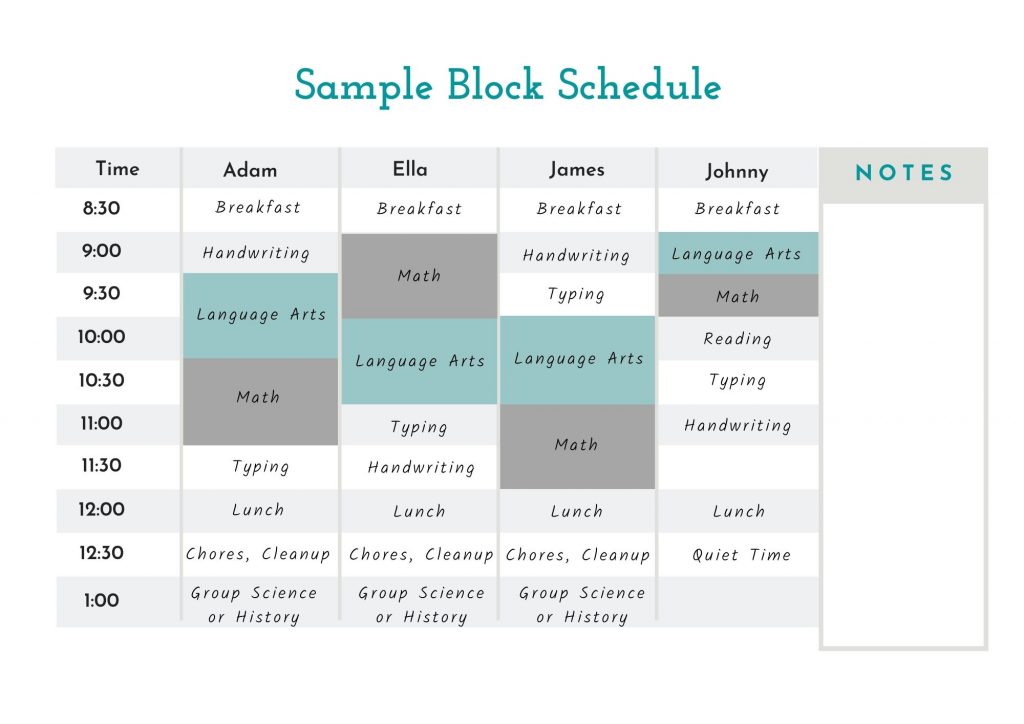
If you choose to use a block schedule, make sure to have a backup plan for how to handle interruptions. Some families have a “scaled down” schedule, or a Plan B, that they use when unexpected events occur.

Homeschool Relaxed Schedule
With a relaxed schedule, the focus isn’t on the exact time of day schoolwork is done, but rather that a student completes the necessary subjects in a general period of time. This is ideal for families who like routine but find that working with a strict schedule creates stress.
- These children have bigger gaps in their days than those with a block schedule, which works well for younger children or those who can’t sit still very long.
- A relaxed schedule is a semi-structured homeschool plan, but it is also very flexible for your family’s needs. This family keeps Fridays open for field trips, appointments, and other things that come up.
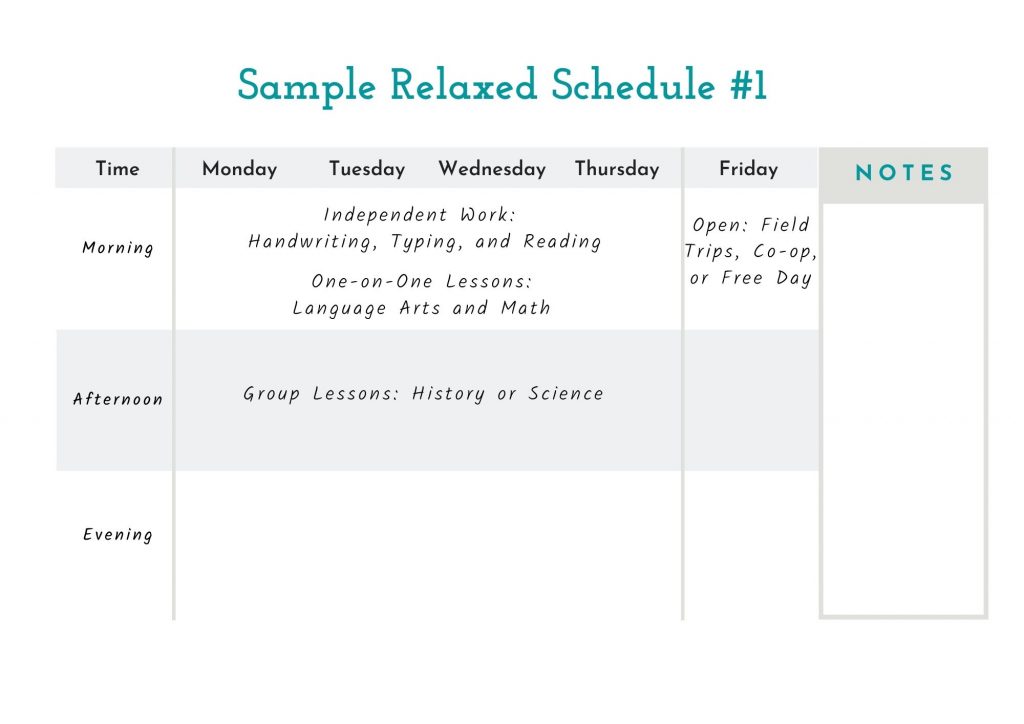
This second example is how one family schedules their homeschool hours around the parents’ work schedules. Many families find that evenings and even weekends work well for school lessons. Our easy-to-teach, open-and-go courses make this type of scheduling ideal for families that need flexibility.
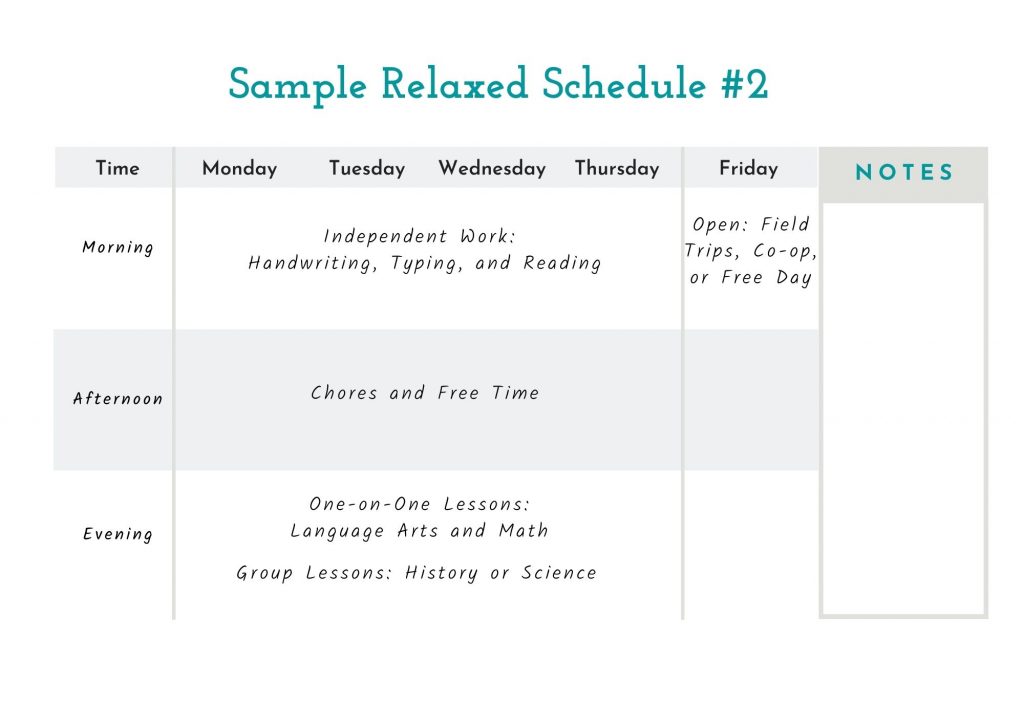

Homeschool Loop Schedule
An even more relaxed schedule is a loop schedule. This family has decided how many times they would like to cover each subject every week. They organize the information into a list and begin working at the top of the list.
Schoolwork is not done at a particular time; instead, children complete lessons whenever is best for them each day. When they finish the list, they just return to the top and start again. Our family-style courses fit perfectly into a loop schedule, as parents teach history and science to a variety of ages at one time.
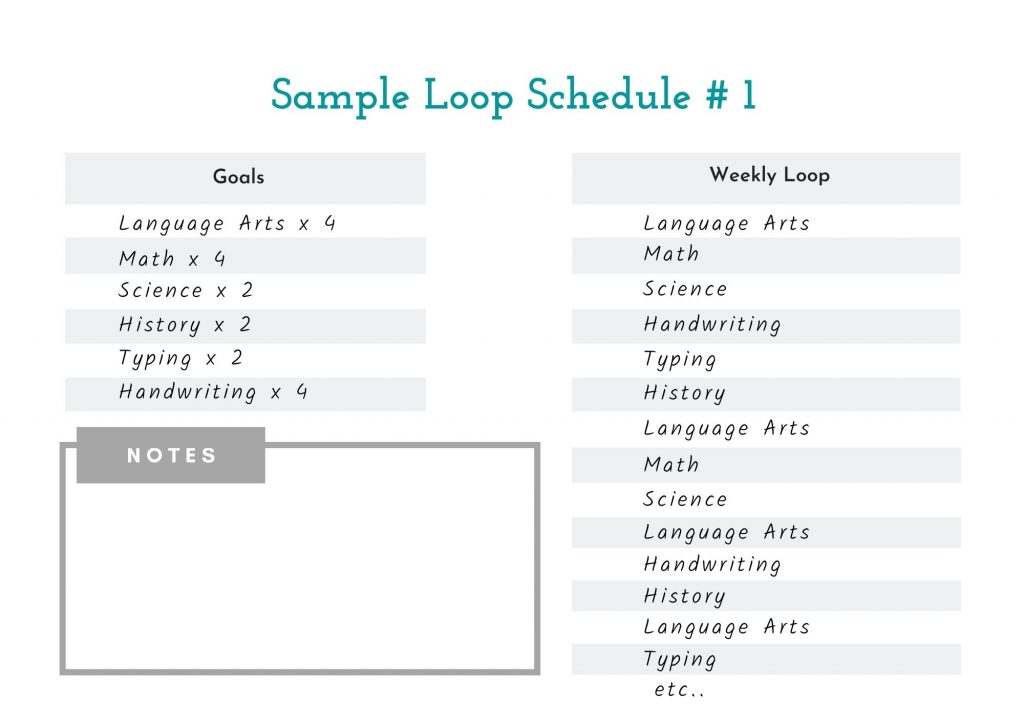
Homeschool parents understand that unexpected events interrupt school time, and sometimes it can be difficult to adjust timed schedules to allow for those interruptions. A loop schedule accommodates this.
Loop schedules are great for families who know which subjects they want to cover but also need extra flexibility in how much time is spent on any subject. If children become very interested in a particular botany concept, for example, parents can expand on it for as long as they’d like. A family then spends less time on lessons that the children have learned quickly.
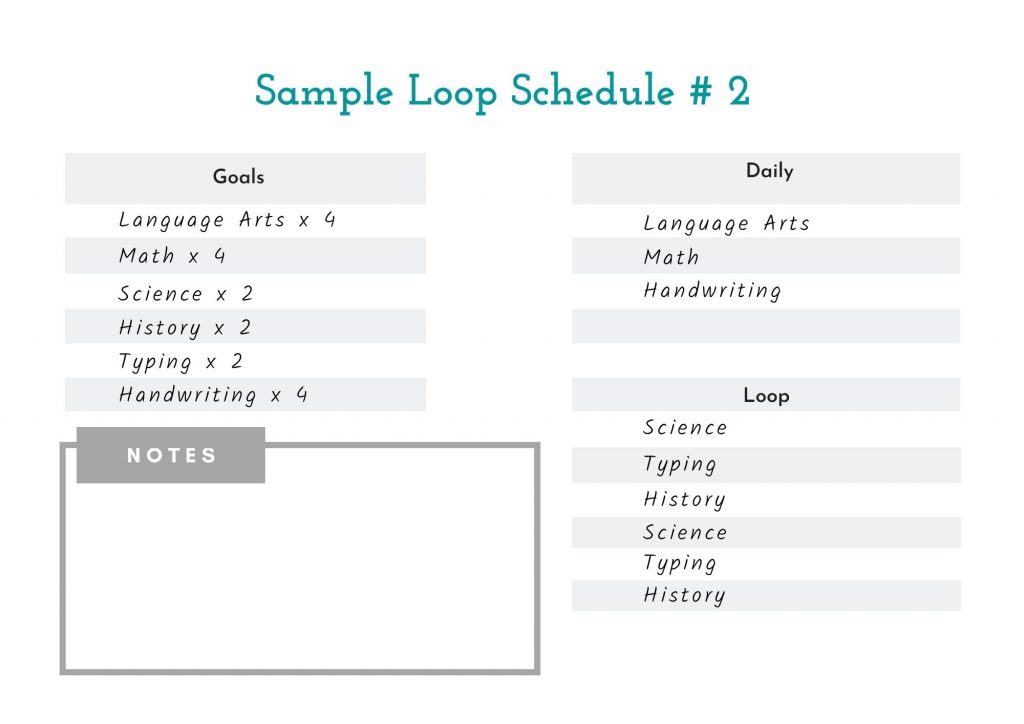
This second sample shows a loop schedule where a child completes a few core subjects (language arts, math, and handwriting) daily, and rotates other subjects throughout the week. This works great for courses that do not need to be completed every day and are done family-style, like history or science, and electives like typing or arts and crafts.

Homeschool Checklist
Our last schedule is a simple daily or weekly checklist to keep both students and parents focused on the tasks to be completed, but not at any specific time.
- This schedule works well for older children: a checklist teaches older children how to manage their time, a necessary skill in adulthood. The Good and the Beautiful curriculum fosters independence as children mature and become more independent with their learning.
- Checklists are also great visuals for children of any age. A checklist shows the tasks to complete each week and easily complements any other scheduling style as a management tool.
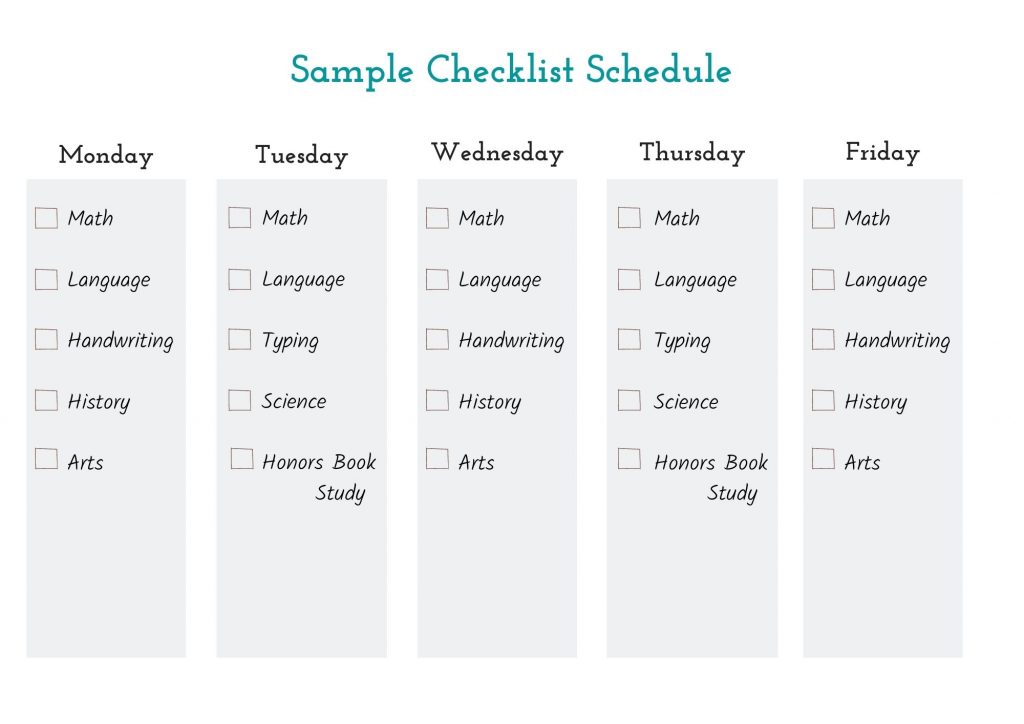
When choosing a schedule style, consider which children and subjects need more one-on-one time and those children who can work independently. Many parents are surprised at the young age children are able to complete lessons, or parts of lessons, on their own. This contributes to a love of learning and independence, which are so valuable for a child’s self-confidence!

Finally, be flexible and give yourself grace.
While there is no one-size-fits-all solution, the beauty of homeschooling is that formal education doesn’t need to happen during typical school hours. Saturdays, evenings … schoolwork can happen anytime!


Our courses provide you with not only flexibility but also the academic rigor needed to give your children a well-balanced, high-quality education! If you are unsure of what is the best fit for your family, try out a few different ways of scheduling your days to learn what works and what doesn’t. Many homeschool parents rotate different schedules in different years, or even in the same school year.
This is the true good and beautiful aspect of homeschooling. It’s up to you. Your schedule must fit your family at any given time. Learn from others, but make it your own too!
You may also like . . .

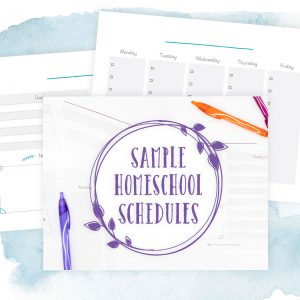

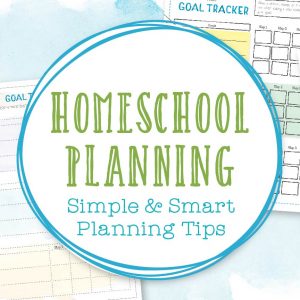




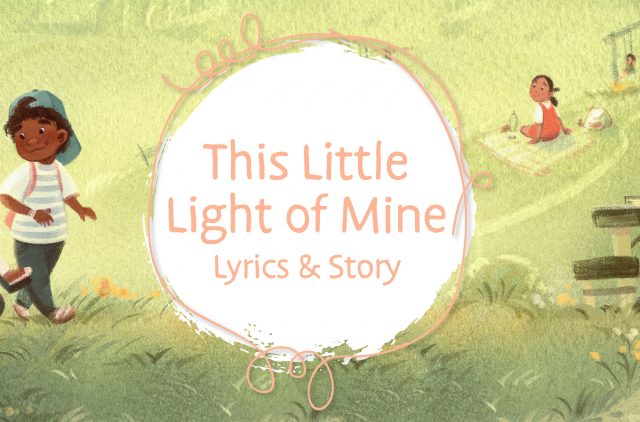






Comments
Wow – this is just incredible! First you provide such beautiful, engaging, thorough curriculum, and now you’re giving us these amazing ideas for how to run a homeschool schedule with such different options. I can’t tell you how many bajillion videos on YouTube I had to go through to gather the information you shared above with different schedule options. I went to a brick and mortar school and always believed “school at home” with allotted time slots was the only way to do school. If only I could have seen this back then, I could have come to what I do now, which is more of a loop. The struggle it took to finally get there, wow. But here it is, in a simple post, I hope many future homeschoolers come across this way ahead of time and can be themselves from the beginning and understand that homeschooling can look so different and to find what works for you. I really hope you can have a virtual conference this year. This curriculum has been such an incredible part of my homeschool journey that I almost gave up on… and this curriculum was a huge part of helping me reconsider and push forward. It also took away my past trauma’s with math. I love the math curriculum and am so amazed at what my first grader understand and can do (she started with your Simply Good and Beautiful Math K) without any tears. Who could ever have dreamed that math would be pleasant. I’m also beyond touched by how Jenny has made such huge sacrifices to make this happen. Nobody has to tell me that Jenny is a woman of God and that God gave her this mission to bless and positively shape a generation of Christian children in such a dark day. I feel beyond blessed that Jenny had this vision up and running in time for me to homeschool my children and what she brings resonates with me – teaching beautiful things and upstanding moral values. God bless Jenny and all the team that makes this curriculum possible to shape our children’s lives beautifully.
I have been struggling on finding us a schedule and how to stay on a routine and these samples really helped. Excited to try them out and see which one works for us.
Thank you for this. Going into 1st/2nd Grade and I feel like we need more of a schedule but not strict. I love the checklist style mixed with relaxed. So informative and easy to read.
Thank you so much for this. We are going into 1st/2nd grade and while I don’t think we need a strict schedule, I think we need something. I love the outlines of the relaxed and check box schedules.
Love these!! Thank you. This was so helpful!